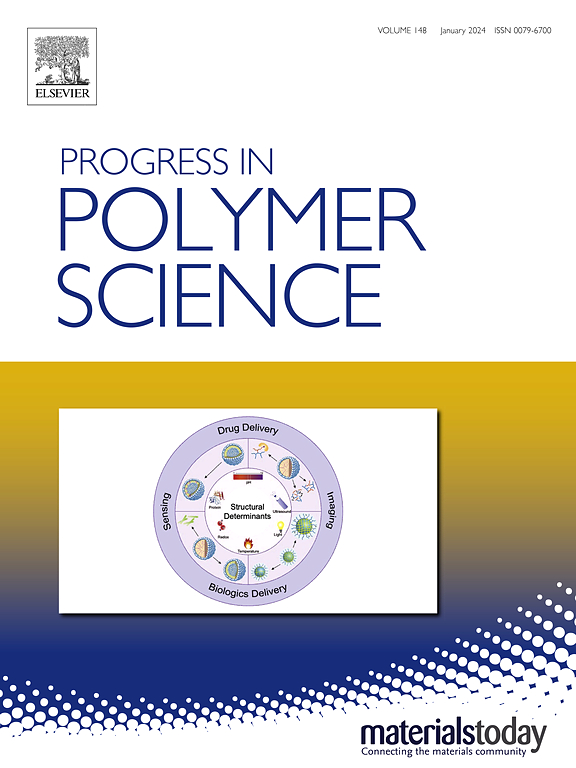用于藤壶和冰释放的油注入有机硅弹性体:目前的了解状态
IF 26.1
1区 化学
Q1 POLYMER SCIENCE
引用次数: 0
摘要
污垢和污染物在表面上的粘附是一个众所周知的问题,特别是在海洋环境中,这可以通过使用适当的涂层来解决。多年来,有机硅弹性体因其对各种污垢的释放性能而脱颖而出,允许使用低应力清洁这些表面。在有机硅弹性体中添加非反应性有机硅流体通常被认为是进一步提高其释放性能的一种方法。然而,这种改善背后的机制仍然很不清楚,流体的影响在很大程度上是不可预测的,并且总是通过实验来评估。因此,本综述试图通过确定藤壶和冰释放的实验观察趋势,并提出理论工具来解释和潜在建模或预测这些趋势,从而解决这一问题。考虑到这一目标,本文将分为三个部分,首先描述有机硅弹性体的化学性质,同时强调可以调整弹性体最终性能的参数。在第二部分中,将讨论有机硅弹性体的物理性能(模量、厚度、表面能)对其卸冰性能的影响。在本节及以后的章节中,将强调对这些污染物的观察结果之间的强烈相似性。最后,将仔细研究含流体硅弹性体的报告,以检查相容性、分子量、表面张力和交联密度等参数的潜在影响。在这个讨论中,潜在的机制背后的释放性能的改进将被强调和理论考虑的支持。本文章由计算机程序翻译,如有差异,请以英文原文为准。


Oil-infused silicone elastomers for barnacle and ice release: The current state of understanding
The adhesion of foulants and contaminants on surfaces is a well-known problem, particularly in the marine environment, which can potentially be solved by the use of an appropriate coating. Over the years, silicone elastomers have stood out for their release performance toward various foulants, allowing the cleaning of these surfaces using low stresses. The addition of non-reactive silicone fluids into silicone elastomers has often been presented as a way to further enhance their release properties. However, the mechanism behind this improvement remains quite unclear and the effect of fluids is largely unpredictable and always assessed experimentally. This review thus attempts to tackle this issue by identifying trends in experimental observations made on barnacle and ice release and proposing theoretical tools to explain and potentially model or predict them. With this objective in mind, this review is divided into three sections and will first describe the chemistry of silicone elastomers while highlighting the parameters that allow tuning the elastomer’s final properties. In the second section, the influence of the physical properties of the silicone elastomer (modulus, thickness, surface energy) on its barnacle and ice-release properties will be discussed. In this section and further, strong similarities will be highlighted between observations made for these foulants. Finally, reports of fluid-containing silicone elastomers will be scrutinized to examine the potential impact of parameters such as compatibility, molecular weight, surface tension, and crosslink density. During this discussion, the potential mechanisms behind the improvement of release properties will be highlighted and supported by theoretical considerations.
求助全文
通过发布文献求助,成功后即可免费获取论文全文。
去求助
来源期刊

Progress in Polymer Science
化学-高分子科学
CiteScore
48.70
自引率
1.10%
发文量
54
审稿时长
38 days
期刊介绍:
Progress in Polymer Science is a journal that publishes state-of-the-art overview articles in the field of polymer science and engineering. These articles are written by internationally recognized authorities in the discipline, making it a valuable resource for staying up-to-date with the latest developments in this rapidly growing field.
The journal serves as a link between original articles, innovations published in patents, and the most current knowledge of technology. It covers a wide range of topics within the traditional fields of polymer science, including chemistry, physics, and engineering involving polymers. Additionally, it explores interdisciplinary developing fields such as functional and specialty polymers, biomaterials, polymers in drug delivery, polymers in electronic applications, composites, conducting polymers, liquid crystalline materials, and the interphases between polymers and ceramics. The journal also highlights new fabrication techniques that are making significant contributions to the field.
The subject areas covered by Progress in Polymer Science include biomaterials, materials chemistry, organic chemistry, polymers and plastics, surfaces, coatings and films, and nanotechnology. The journal is indexed and abstracted in various databases, including Materials Science Citation Index, Chemical Abstracts, Engineering Index, Current Contents, FIZ Karlsruhe, Scopus, and INSPEC.
 求助内容:
求助内容: 应助结果提醒方式:
应助结果提醒方式:


